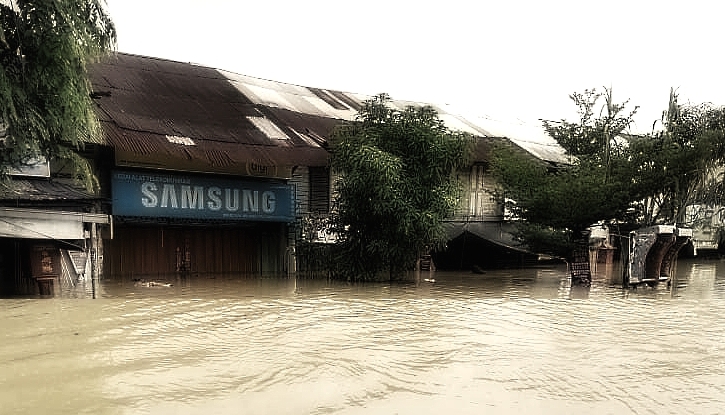
Sin Chew Daily
Every year, the northeast monsoon season from November through February will invariably bring floods to Malaysia's three east coast states, pouring almost 40% of the annual rainfall of 2,500mm and sending tens of thousands into relief centers.
While this is largely a natural disaster, the human factor can never be negated at all.
For one thing, the water catchment areas in mid and upper stream of major rivers have been deliberately logged and converted into oil palm estates.
Additionally, the government has not done much over the decades in mitigating the floods, especially during the year-end rainy season.
Not only the east coast states, even Kuala Lumpur, the nation's capital and predominant metropolis, will get instantly flooded after an hour of heavy downpour. The authorities seem to be helpless in fixing the problem except waiting for the floodwaters to recede. As for the victims, they have to spend time doing the massive clean-up and take every precautionary measure before the next flood strikes.
No doubt fixing the floods in the east coast is way more difficult, but what often happens in Klang Valley is typically the consequence of human negligence because of poor urban drainage, clogged drains and inefficient dams or reservoirs supposed to help mitigate floods.
Besides, we also do not have many rivers or storm sewers large enough to drain the stormwaters, with the broader ones often too shallow — less than five feet from the base to road surface — to efficiently drain the surface runoff.
The authorities should enlighten us how large is the holding capacity of our flood mitigation systems. This should be properly planned out based on meteorological data available, including deepening the river bed and broadening the drains during the dry season, and building dykes and additional stormwater drains. It is impossible for the government to fail to fix the flood problem, at least to prevent annual floods, if sufficient effort has been put in.
The Netherlands has a population of 17.3 million people inhabiting a land area of only 41,526 square kilometers, 26% of which is below sea level and half of the country's total land area barely a meter above sea level.
A massive flood in 1953 forced the Dutch government to erect a massive dyke to fend off another disaster. Today, the Dutch have learned that floods are actually a product of inappropriate human use of land and rivers, and human factor is the culprit behind the so-called "natural" disasters.
In Taiwan, when the typhoon strikes in the summer, a massive downpour can normally last more than ten hours with over 300mm of rainwater. Nevertheless, flooding is relatively rare in Taipei, thanks to the city's well developed drainage system.
That said, landslides and mudslides are not totally unheard of in Taiwan because of illegal logging and areca palm cultivation on hill slopes decades ago.
While the Dutch are fighting to claim back usable land from the North Sea, and the Taiwanese having to face the constant threats of earthquakes and typhoons, we in Malaysia are a whole lot luckier. Unfortunately, our cities and towns still get paralyzed after a heavy downpour lasting more than an hour.
While the Dutch and the Taiwanese have planned for may generations ahead, it is high time for the Malaysian government to kickstart our "ten-year flood mitigation action plan".
Firstly, flood mitigation should be incorporated into the government's annual budgets and KPI. Secondly, all forest land clearing activities must be stopped immediately and keep our water catchment areas intact. Thirdly, build flood prevention dams and barrages. Fourthly, deepen river beds from time to time to facilitate drainage. Fifthly, build flood control dykes in downstream of major rivers. Sixthly, improve the existing drainage system and lastly, unclogging our drains and rivers on a regular basis.
The annual floods will be significantly reduced if we really get down to work.
Even a massive monster like the Yellow River in northern China could be tamed by Emperor Yu the Great more than four thousand years ago, employing only the most primitive scientific methods to bring the 5,464km long river into submission.
If he could, why not our leaders today who have the most sophisticated technologies and comprehensive information at hand?
ADVERTISEMENT
ADVERTISEMENT


































